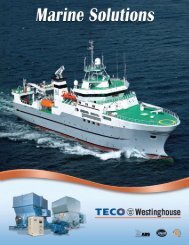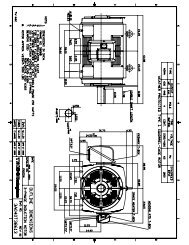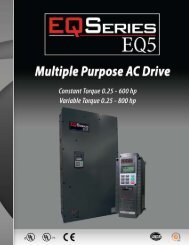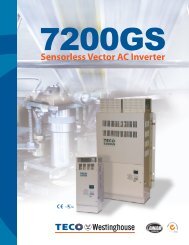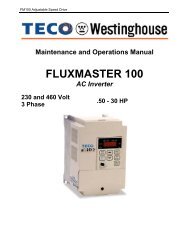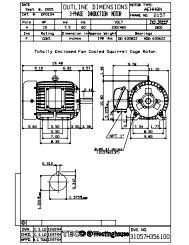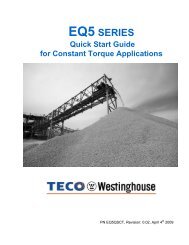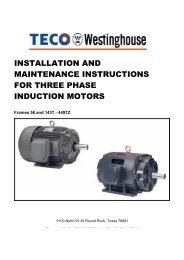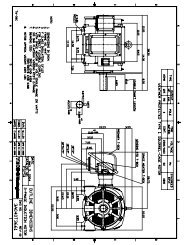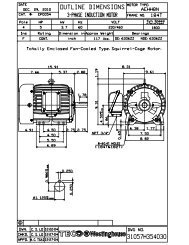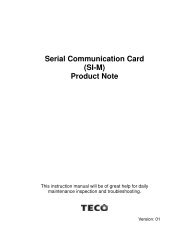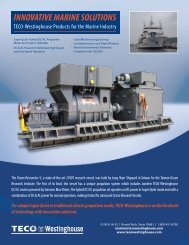EQ7 Series Instruction Manual - TECO-Westinghouse Motor Company
EQ7 Series Instruction Manual - TECO-Westinghouse Motor Company
EQ7 Series Instruction Manual - TECO-Westinghouse Motor Company
Create successful ePaper yourself
Turn your PDF publications into a flip-book with our unique Google optimized e-Paper software.
Even if selecting "Trip after decelerate-to-stop" or "Continue to run," the inverter may not be able to do so<br />
when the load's inertia is small or the load is heavy, due to undervoltage caused by a control delay. In<br />
such a case, when "Trip after decelerate-to-stop" is selected, the inverter allows the motor to coast to a<br />
stop; when "Continue to run" is selected, the inverter saves the output frequency being applied when the<br />
undervoltage alarm occurred and restarts at the saved frequency after a recovery from the momentary<br />
power failure.<br />
When the input power voltage for the inverter is high, setting the continuous running level high makes the<br />
control more stable even if the load's inertia is relatively small. Raising the continuous running level too<br />
high, however, might cause the continuous running control activated even during normal operation.<br />
When the input power voltage for the inverter is extremely low, continuous running control might be<br />
activated even during normal operation, at the beginning of acceleration or at an abrupt change in load.<br />
To avoid this, lower the continuous running level. However, possible undervoltage results from voltage<br />
drop due to a control delay if set too low.<br />
Changing the continuous running level, make sure that the continuous running control will be performed<br />
properly, by considering the fluctuations of the load and the input voltage.<br />
F15, F16 Frequency Limiter (High), Frequency Limiter (Low) H63 Low Limiter (Mode selection)<br />
• Frequency Limiter (High and Low) (F15, F16) Data setting range: 0.0 to 500.0 (Hz)<br />
F15 and F16 specify the upper and lower limits of the output frequency or reference frequency, respectively. The<br />
frequency to which the limit is applied differs depending on the control system, as seen in the table.<br />
Frequency Limiter<br />
V/f control<br />
Frequency to which the limit is applied<br />
Vector control without/with speed sensor<br />
Frequency Limiter (High) F15 Output frequency Reference speed (reference frequency)<br />
Frequency Limiter (Low) F16 Reference frequency Reference speed (reference frequency)<br />
When the limit is applied to the reference frequency or reference speed, delayed responses of<br />
control may cause an overshoot or undershoot, and the frequency may temporarily go beyond the<br />
limit level.<br />
• Low Limiter (Mode selection) (H63)<br />
H63 specifies the operation to be carried out when the reference frequency drops below the low level specified by<br />
F16, as follows:<br />
Data for H63<br />
Operation<br />
0 The output frequency will be held at the low level specified by F16.<br />
1 The inverter decelerates to stop the motor.<br />
(H63 = 0) (H63 = 1)<br />
• When changing the frequency limiter (High) (F15) in order to raise the reference frequency, be sure to<br />
change the maximum frequency (F03) accordingly.<br />
• Maintain the following relationship among the data for frequency control:<br />
F15 > F16, F15 > F23, and F15 > F25<br />
F03 > F16<br />
where, F23 and F25 specify the starting and stop frequencies, respectively.<br />
If any erroneous data for these function codes is entered, the inverter may not run the motor at the<br />
desired speed, nor start it normally.<br />
4-49



